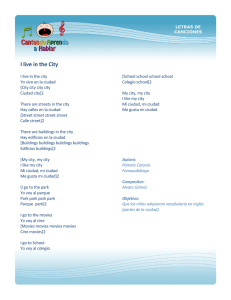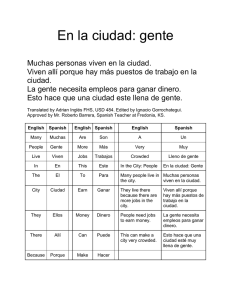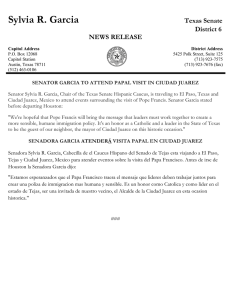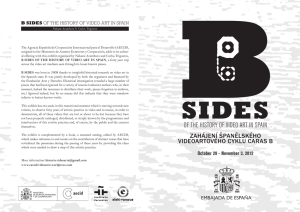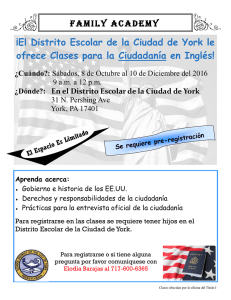Written Cities of Ibero-America: Architecture and Literature
Anuncio
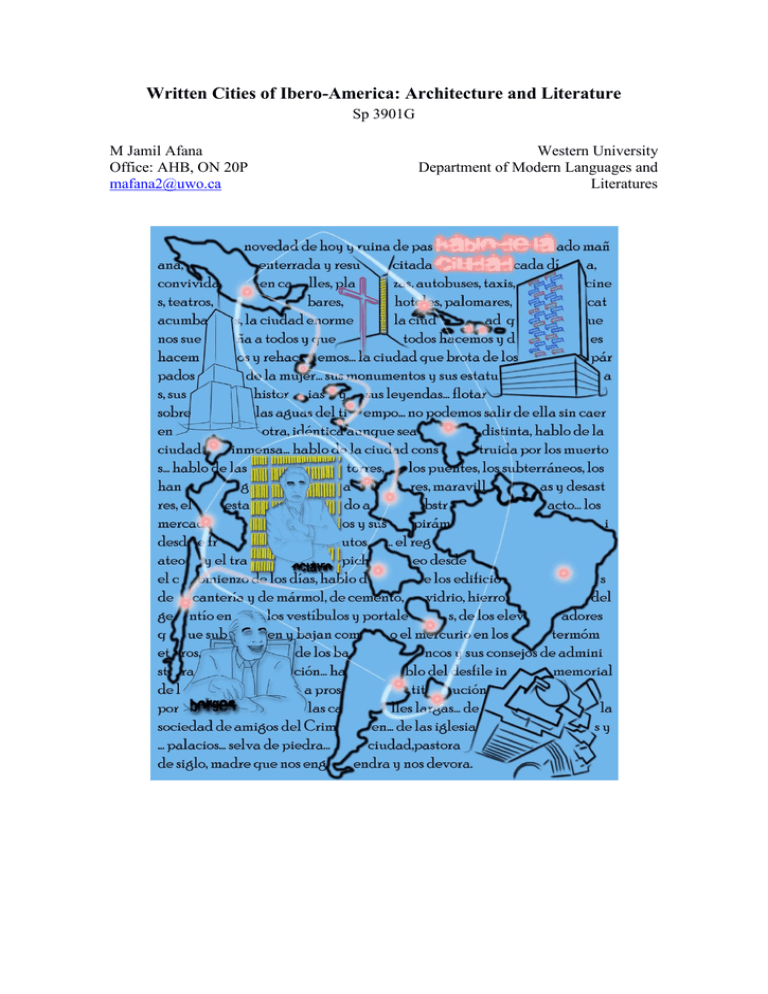
Written Cities of Ibero-America: Architecture and Literature Sp 3901G M Jamil Afana Office: AHB, ON 20P mafana2@uwo.ca Western University Department of Modern Languages and Literatures I. COURSE DESCRIPTION The discourse on the identity of the Ibero-American territory is constantly being reimagined and reinterpreted. The course, Written Cities of Ibero-America: Architecture and Literature will renovate students’ understandings of Hispanic culture, its multiple identities, and the people´s habitat in contemporary Ibero-American cities. This interdisciplinary course provides an introduction to Ibero-American culture through a journey across the written cities, which include: Mexico City, Havana, Montevideo, Buenos Aires, Lima, Panama, Guatemala, San Jose, Bogotá and Santiago de Chile. Close attention will be paid to the connections between contemporary culture and cultural diversity with the cities’ origins and foundations, which will be explored through the analysis of architectural and literary production. II. COURSE AIMS This course is built upon interdisciplinary topics and how they convey the interrelationship between the construction of the city and literary creation. Based on this principle, the course objectives are as follows: -Provide students with basic knowledge of the cultural diversity that exists in the IberoAmerican territory. To do this, students will explore and analyze the architectural and literary spaces of the aforementioned cities and recognize their cultural significance. -Develop students’ imagination and perceptions of Ibero-American cities through the execution of specific tasks. In the exercise of Mapping the Territory, students will render an image of each city on paper in order to reveal their perceptions and interpretations of each city. In the activity of Exploring London, students will gain a thorough understanding of the space that they inhabit through on-site visits to The Museum of London and local architecture studios. Exploring London will allow students to develop their spatial imaginations, which is directly relevant to the conceptualizations that occur in course work, such as the need to imagine distant cities and situations. -Develop students’ critical thinking and creative skills as well as foster interest in the different cultures of Ibero-America. -Generate interest among students in the disciplines of architecture and literature as potential future career paths. III. LEARNING OUTCOMES As a result of the above aims, students will be able to: - Identify the Ibero-American territory, culture, and its artistic expressions. -Complete the various assignments based on the architectural and literary skills they have acquired, which will enable them to study and analyze any city through architectural and literary discourse. 1 -Develop their abilities to express themselves in both oral and written Spanish in order to write an academic essay. The volume and complexity of the required readings are suited to the students´ level of Spanish. Readings include specific passages of selected works. For every hour of class, student will be required to read about 10 pages; that is, in a week (3 class hours) the reading materials not exceed 30 pages. IV. EVALUATION The method of evaluation is directly reflective of whether students have succeeded in grasping the main aims of the course. In-class participation relates directly to the content of the required readings and theories; while assignments, visits, work proposal, team presentation, and final essay are oriented towards practical research. The percentages and explanations of each activity are: 15% Attendance and participation: Punctual attendance and continuous participation in class will be well documented are required in order to achieve a high mark in the course. 20% Exploring London: The class will visit important places in the City of London where students will be required to describe buildings through drawings or/and writing. Attendance at visits and the submission of drawings are required. Drawings will be submitted at the end of each visit. 30% Mapping the Territory: In this creative exercise, students will draw a map of each ‘Written City’ (10 in total). Throughout the course students will mentally construct an image of each city. Each student will present his/her own interpretation on paper. 10% Work proposal and oral presentation: Students can work in groups of up to three students. Each group will choose an Ibero-American city (that is not covered in the course outline) and each group will analyze it using architectural and literary language. 25% Final essay: Students have the option to work in groups. Once the proposal is approved, they will be able to write the final essay. The essay will be 10 pages long including bibliography. VII. ESTRUCTURE In this course we will study 10 cities and spend 2 classes (3 hours) per city. The material that will be presented in class by the professor is indicated by [] and the material that students are required to read in preparation for classes is indicated by []. The assigned readings [] will be discussed during the lecture in class. The course outline is as follows: INTRODUCCIÓN Week 1 1.1 Presentación del curso – programa Cuadros cronológicos y áreas geográfico-culturales 2 1. CIUDAD ESCRITA: CIUDAD DE MÉXICO La ciudad contemporánea. Week 1 El área metropolitana y su distribución estructural. 1.2 Week 2 2.1 “Diferenciación socioespacial en la zona Metropolitana de la Ciudad de México”. Enrique Pérez Campuzano y Clemencia Santos Cerquera “La revitalización del centro histórico”. Alejandro Suárez Pareyón o La ciudad en la poesía contemporánea. “Hablo de la ciudad”. Octavio Paz “Teotihuacan; Ciudades; Mapa”. José Emilio Pacheco El arte de escribir. José Villagrán. Juan O ‘Gorman. Carlos Obregón. Mario Pani. Luis Barragán. Ricardo Legorreta. Félix Candela. o El origen de la ciudad y el de la nación. “El centro histórico de la ciudad: presente y futuro”. Alejandro Suárez Pareyón. 2. CIUDAD ESCRITA: LA HABANA El país prohibido y sus orígenes. Week 2 “Repensar la Habana: en búsqueda de la sustentabilidad 2.2 Week 3 3.1 urbana”. Gina Rey o El centro vivo. “La Habana desde el centro: el hábitat en la zona antigua”. Rosendo Mesías González o La ciudad en la novela. “La ciudad de las columnas”. Alejo Carpentier 3. CIUDAD ESCRITA: MONTEVIDEO El centro vivo de Montevideo. Week 3 “Área central y hábitat popular”. Raúl Vallés Barreto 3.2 Week 4 4.1 Week 4 4.2 o La ciudad de Santa María. Primera parte: “La vida breve”. Juan Carlos Onetti “Si hubiera si pudiera”. Idea Vilariño o La ciudad de Santa María. Primera parte: “La vida breve”. Juan Carlos Onetti Video: “Recorrer la ciudad con Eduardo Galeano”. YouTube o Primera visita en la ciudad de London. Museum of London. Govent Garden. 4. CIUDAD ESCRITA: BUENOS AIRES La Gran Buenos Aires. Week 5 “Buenos Aires ¿quién es la “Reina del Plata”?”. Rodolfo 5.1 Week 5 Bertoncello o La estructura urbana de la ciudad. “Las divisiones espaciales de la Ciudad de Buenos Aires”. Victoria Mazzeo, María Lago Video: “La ciudad Moderna a través de la fotografía”. YouTube o La ciudad como una casa. 3 5.2 “Casa tomada”. Julio Cortázar Filosofía aquí y ahora: “La metáfora de casa tomada”. YouTube “Arrabal” “Las calles” “Un patio”. Jorge Luis Borges 5. CIUDAD ESCRITA: LIMA Construyendo una imagen de Perú. Week 6 Primera parte: “Introducing Lima: The Strangest, Saddest City” 6.1 Week 6 6.2 Week 7 Winter Break Week 8 8.1 James Higgins o La ciudad como un cuento. “A tale of two cities: Lima, and the construction of colonial representation”. Tom Cummins o La ciudad a través de la historia. “Lima Cuadrada, Lima Virreinal, Lima Aristocrática y Lima Metropolitana”. Blog “El hábitat en el centro histórico”. Cesar Cerrón Estares o Segunda visita en la ciudad de London. Nicholson Sheffield Architects. Architects Tillmann Ruth Robinson. 6. CIUDAD ESCRITA: PANAMÁ La ciudad de los rascacielos. Week 8 “Panamá viejo: una experiencia exitosa de gestión patrimonial” 8.2 Week 9 9.1 Juan Guillermo Martín, Julieta de Arango “Ibero-América”. Demetrio Korsi o La ciudad como escenario. “Presentación de la ciudad de Panamá: grandes corredores urbanos”. Álvaro Uribe “La ciudad vieja”. Pedro Rivera o La ciudad a través de la poesía. “Panamá viejo”, “Panamá”. Ricardo Fábrega “El canal de Panamá”. Alma Pérez Video: “EL canal de Panamá” 1. 2 Youtube, Vimeo VIAJE DE VUELTA A LA CIUDAD DE MÉXICO “PELÍCULA” La arquitectura coloreada. Week 9 Película The Quit Revolution. Luis Barragán 9.2 o Barragán Foundation. www.baragan-foundation.com 7. CIUDAD ESCRITA: GUATEMALA El Valle Central Guatemala con las antiguas y la actual capital. Week 10 “Desarrollo de la estructura espacial en la ciudad de Guatemala: 10.1 Week 10 10.2 desde su fundación hasta la revolución de 1944”. Gisela Gellert o La ciudad como resultado de traslado. “Pasado y presente de una ciudad colonial: La Antigua Guatemala”. Marta Herrán Alonso o La ciudad a través de la poesía. Cuento: “La fe y las montañas”. Augusto Monterroso Conferencia: “El futuro del pasado: para que La Antigua Guatemala perdure y viva”. Marco Antonio To Quiñónez 4 Video: “arquitectura, música y paisaje”. Vimeo Video: “Guatemala y sus alrededores”. Vimeo 8. CIUDAD ESCRITA: SAN JOSÉ El corazón de Costa Rica. Week 11 “El espacio público en nuestras urbanizaciones de vivienda de 11.1 Week 11 11.2 interés social”. Daniel Morgan Ball o Poesía urbana. “Una poética de las márgenes urbanas: Lima y San José”. Kuhnheim Jill S. o “La ciudad y el lenguaje se parecen. A los dos los construye el hombre… la ciudad es como un discurso que tiene su sintaxis, sus palabras y vericuetos, sus faltas de ortografía y sus silencios.” Roberto Villalobos Ardón “La ciudad de San José: espacio, discurso y poder”. Pilar Herrero Uribe Video 1, 2: “Arquitectura y vida urbana de San José contemporáneo”. YouTube Entrevista: “Alberto Linner”. YouTube 9. CIUDAD ESCRITA: BOGOTÁ La ciudad abanico. Week 12 “Presentación de la ciudad de Bogotá: Transmilenio, 12.1 Week 12 12.2 metrovivienda, centros educativos distritales y espacio público”. Nora Arestizabal, Elsa Mahecha, Andrés Ortiz o La calle. “Vendedores de objetos insólitos”. Celso Román “Construcción social de espacio público en barrios populares de Bogotá”. Jaime Hernández García o Habitar las alcantarillas. Continuar con: “Construcción social de espacio público en barrios populares de Bogotá”. Jaime Hernández García Documental: “Living in the Sewers of Colombia”. YouTube 10. CIUDAD ESCRITA: SANTIAGO DE CHILE La ciudad. Week 13 “Santiago de Chile: ciudad propia, ciudad bárbara”. Francisca 13.1 Week 13 13.2 Week 14 14.1 Márquez o La ciudad en 34 segundos. Instalación: “Un logo para América. New York 1987”. Alfredo Jaar Entrevista: “La ciudad del espectáculo”. Alfredo Jaar Video: “La imagen de la ciudad”. YouTube “Poema 48: La ciudad”. Gonzalo Millán o Laberintos urbanos en América Latina. “La ciudad multicultural”. Jordi Borja, Manuel Castells Conferencia: “La poesía dice y la arquitectura hace”. Grupo Valparaíso 1952: Alberto Cruz “Andar en la ciudad” Michel de Certeau o Conclusiones. Hablar del curso y los objetivos conseguidos. 5 Week 14 14.2 o Trabajo final. Presentación y división de grupos. Resolver dudas del trabajo final If you have any inquiry before the beginning of classes, please, do not hesitate to contact me: mafana2@uwo.ca UWO Academic Policies V. PLAGIARISM Plagiarism is a major academic offense (see Scholastic Offense Policy in the Western Academic Calendar at http://westerncalendar.uwo.ca/2012/pg113.html. Plagiarism is the inclusion of someone else's verbatim or paraphrased text in one's own written work without immediate reference. Verbatim text must be surrounded by quotation marks or indented if it is longer than four lines. A reference must follow right after borrowed material (usually the author's name and page number). Without immediate reference to borrowed material, a list of sources at the end of a written assignment does not protect a writer against a possible charge of plagiarism. This also applies to work facilitated or written for students by third parties. The University of Western Ontario uses a plagiarism- checking site called Turnitin.com. VI. ABSENTEEISM Students seeking academic accommodation on medical grounds for any missed tests, exams, participation components and/or assignments must apply to the Academic Counseling office of their home Faculty and provide documentation. Academic accommodation cannot be granted by the instructor or department. - Accommodation for Medical Illness: https://studentservices.uwo.ca/secure/medical_accommodations_link_for_OOR.pdf - Downloadable Medical Certificate: http://www.uwo.ca/univsec/handbook/appeals/medicalform.pdf Students are allowed to miss clases without penalti for legitimate reasons (medical issues, family emergencies etc.). Documentation for legitimately missed classes is required at the Dean's Office for Academic Accommodation. Students who miss classes or parts of classes are responsible for the material they missed. Students who miss classes with no legitimate reason will get a zero in participation grade that day. Instructors are not obliged to review the contents of lectures, repeat announcements or retain notes, handouts or overheads. Any student who, in the opinion of the instructor, is absent too frequently from class (lectures and/or homework days), will be reported to the Dean of the Faculty offering the course (after due warning has been given). On the recommendation of the department concerned, and with the permission of the Dean of that Faculty, the student will be debarred from taking the regular examination in the course. The Dean of Faculty of Registration: http://www.uwo.ca/univsec/handbook/exam/attendance.pdf. Electronic Devices The use of cell phones is completely forbidden in class. If you text, check facebook, twitter, etc. during class, you will be asked to leave the classroom immediately, and will 6 get a zero in participation for that week. You can use laptops for academic purposes, but if you use them to check your email, facebook, etc. you will be asked to leave the classroom as well. This is considered a scholastic offence. Scholastic offences are taken seriously and students are directed to read the appropriate policy, specifically, the definition of what constitutes a Scholastic Offence, at the following Web site: http://www.uwo.ca/univsec/handbook/appeals/scholastic_discipline_undergrad.pdf. Students who are in emotional/mental distress should refer to Mental Health Western: http://www.health.uwo.ca/mental_health/ for a complete list of options about how to obtain help. The Department of Modern Languages and Literature Policies which govern the conduct, standards, and expectations for student participation in Modern Languages and Literatures courses is available in the Undergraduate section of the Department of Modern Languages and Literatures website: http://www.uwo.ca/modlang/undergraduate/policies.html. It is your responsibility to understand the policies set out by the Senate and the Department of Modern Languages and Literatures, and thus ignorance of these policies cannot be used as grounds of appeal. 7
